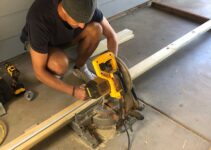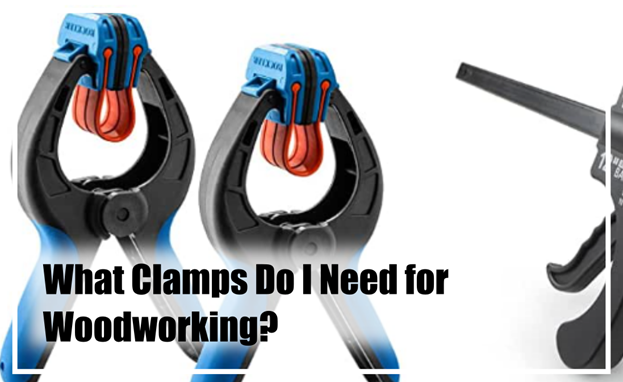
What Clamps do I need for Woodworking?
So a common question amongst woodworkers when starting out is – What Clamps do I need for Woodworking?
There will come a time when you need clamps to be able to produce sturdy woodworking projects—most especially so if your projects require gluing together boards.
But what clamps do you need for woodworking? Do you need woodworking quick clamps? There are so many kinds of clamps, and the ones you need really depend on the kind of projects you make.
Not all clamps are built for the same purpose, so I will share with all different clamps types and what they are used for.
The different types of woodworking clamps
In this section, we will be taking a look at the many types of clamps and what they are used for.
1. G or C-Clamp
This is a versatile clamp that has many uses. Most of the time, you use them to clamp long and thick boards onto your workbench. The clamp has a jaw that you can adjust in size. The smallest is one inch, but there are clamps whose jaws can be as wide as eight inches.
The C-clamp has a screw that has a flat head. It is this screw that moves the jaw up and down. Or open and shut. They are best used in irregular surfaces. They are best used if you want to plane or sand the wood.
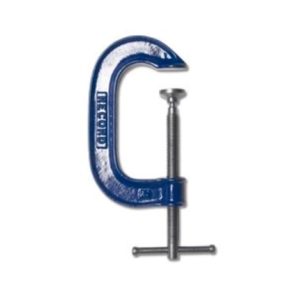
2. Hand Screw Clamp
This is a kind of clamp that has two jaws. Each jaw has a screw that you turn to tighten it. These clamps are mostly used in furniture repair—they can hold pieces together while you work on these broken pieces. The screws have handles, so you do not need an extra tool to tighten them.
Most of the time, the hand screw clamp is used for angled pieces. Clamps like this come in metal, but many manufacturers today now offer wooden clamps, too.
3. Spring Clamp
This is the most common type of clamp that you will find in woodworking spaces. A spring clamp is a basic one that has a jaw—a jaw which is already tight. You press the handles to open that jaw, and then insert the material inside before letting go of the handle
The clamp has a spring, and it is this spring that pushes the mouth together. The clamp can only be used according to the size of its mouth. As such, this clamp comes in many sizes. The spring clamp is versatile, but you cannot use them if you are gluing together from the side; they are best used for gluing wood on top of each other horizontally.
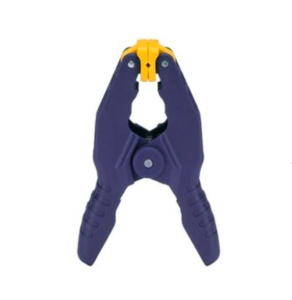
4. Bench Clamp
This is a clamp that uses a spring—the mechanism is similar to a plumber’s vice grip. It is best used for making a wood stay put on a workbench. The end of the clamp has a screw, which is what you use to adjust the tightness of the clamp.
Many people also use this for welding projects, not only woodworking. The clamp is versatile, and it comes in many styles. This clamp is also one of the most affordable among all clamps.
5. Bench Vise
A bench vise is something that you install on your workbench. It is a heavy clamp that looks like an anvil. The bench vise is used to put wood in a solid and steady position on your bench. Most woodworkers use this if they need to sand or plan a long piece of wood.
Bench vises have adjustable mouths. There is a metal handle at the side that you use to tighten or loosen the mouth. The bench vise is portable, but it is heavy. Use a bench vise if you do a lot of drilling. You can also use the vise to tighten the wood if you need to saw it.
6. Web Clamp
The web clamp is a round clamp that has a square space in the middle. It also has a tape. Which you pull to tighten it. It is used to wrap frames, and you need a ratchet to tighten it. The clamp is made of four parts. Each part’s inside is straight, while the outer edge is round.
The straight inside edge is what you use to put on the surface of the wood. Once you have positioned all four parts in the four corners of the frame, you tighten the clamp with the belt. What it does is it securely positions and the corners at the right angle while you are letting the glue dry.
7. Mitre Clamp
This is a clamp that has diagonal edges. It is used specifically to put two angled mitres together. As such, the mitred ends that were put together will form a right angle, like a picture frame.
Some mitre clamps come as a rigid set of tools that look like a saw with a base. Some come in the form of spring mitre clamps. The spring mitre clamps look like pliers, and you attach a clamp in the pliers. You use the pliers to open and close the jaws.
As you open the clamp, you release it so it would bite on the two sides of the mitre. When released, the prongs would grab onto the wood, and the spring at the back of the clamp will produce the tension to close the joint.
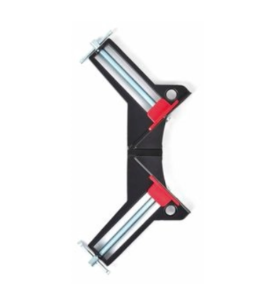
8. Quick Grip Clamps
This is a kind of clamp that looks like a gun. You can use the clamp with only one hand. The gun acts as the pump. On top of the clamp are two heads that serve as the actual clamp.
The jaws of the clamp tighten as you squeeze the trigger. While this clamp is easy to use, it is best used for thin materials—like of you are gluing two pieces of plywood together. While you can use it to clamp boards to your workbench, it is not designed for stability while you are working on the wood itself.
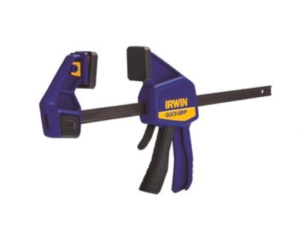
9. Speed Clamp
Like the Quick Grip clamp, this one looks like a gun. At the top of the handle is a long bar that has the jaw. This bar has serrations, and it moves forward to tighten as you pump the handle. The serration is what keeps it from getting loose.
To release the clamp, you have to use a dial at the other jaw to loosen its grip. As you do this, the locking mechanism will get loose, giving the serrations adequate space to move back and forth freely.
10. Right Angle Clamp
This is a clamp that you use if you are trying to secure a right angle. For example, imagine that you have a baseboard and you want to put a wall on top of that base board. They may or may not be of the same thickness.
Since this wall is not going to stand without a hand supporting it, you need to clam the bottom of the wall to the base board that lies on the table or the ground. The only way you can do this is if you have a right-angle clamp.
11. T-Bar Sash Clamp
This is a clamp that you would use when securing/gluing larger jobs, like gluing together table tops and bench tops. They can also be used for smaller where you really need to get some additional pressure on the joins with it’s winding mechanism giving you the ability to really wind the pressure on with little effort.
They come in a variety of lengths depending on the size of job you need them for.
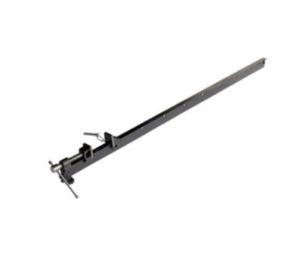
There are many other types of clamps, but these eleven are the most common ones.
What woodworking clamps do I need
Now that you know what clamps are used for what projects, it is time to decide which ones to buy. What I recommend is that you buy at least five types of clamps if you are just starting out. These are clamps that you will find useful no matter what type of projects you do.
These clamps are:
- Right-angle clamps – great if you are making cabinets, dressers, and shelves
- C -clamp – use it for clamping together boards, especially if you have to glue them and leave them to dry overnight.
- Spring clamp – a versatile clamp that you can use in almost any project.
- Web Clamp – awesome tool if you are making boxes or photo frames.
- Bench vise – it is an important tool if you want to secure your wood for sanding, sawing, and planning purposes.
As I mentioned earlier, the types of clamps you need would depend on your woodworking projects. If you are doing a lot of mitred projects, then you definitely need mitre clamps. If most of your work has something to do with flooring, then you need a floor clamp.
But why are woodworking clamps so expensive?
Clamps are expensive because they are made of high-grade materials. Most clamps are made of sturdy plastic, but the spring is what costs that much money.
And of course, the best clamps for woodworking are branded clamps. They are more expensive because they are made with great engineering thought process behind them.
Let us take a look at the prices of the five clamps that I recommend that you buy. All these prices are based on Amazon.
- Right-angle clamps – typically cost $16 or $19 for four pieces. There are other variations that sell for $112 each, but these are made of heavy-duty metal—not something you need unless you do industrial work.
- C -clamp – the cost of this clamp depends on the size. You can buy one piece for as little as $14, while bigger ones can cost $16. But the metal ones as they are cheaper. Some branded c-clamps can cost upwards of $86 each.
- Spring clamp – you can buy this for at least $10 each. At best, you need to buy four pieces. Some of these clamps are affordable that you can buy four pieces of them for $12. Buy the affordable ones as they function in the same way as the branded ones. Just buy new pieces if the springs stop working or if they being to loosen.
- Web Clamp – web clamps cost only $12. Some branded ones cost $30. Before you buy a clamp like this, take a look at the length of the nylon strap. The nylon strap length should tell you if you can use this for your box or photo frame projects or not. It is the nylon that wraps the box, so pay attention to this detail when you buy.
- Bench vise – this is a little expensive, so brace yourself. A bench vise costs no less than $100. Before you buy, read the product details and identify how far the mouth is going to open. You do not want to buy a bench vise that you cannot use.
Summary
Clamps are essential for woodworking—even if you do not need to glue the wooden pieces. Clamps can help you screw together wood on the right angle. They can also help you secure wood when you are driving pocket holes in them.
Clamps are definitely an essential tool for both experienced woodworkers and an essential Woodworking tool for beginners.
Buy different DIY clamps for woodworking by fours. If you are just starting out, you will find each set beneficial. As your business or hobby grows, you would need more clamps—only you can tell how many you need. For now, just buy four pieces for each type or as many as your budget will allow for, as you will never know when the need for them pops up—the last thing you want is to put your task on hold just because you do not have one.
Happy Woodworking
Ben @ Been A Tree Wood

